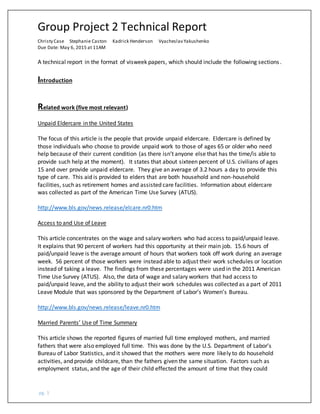
Group Project 2 Technical Report_Visual Analytics
- 1. Group Project 2 Technical Report pg. 1 Christy Case Stephanie Caston Kadrick Henderson Vyacheslav Yakushenko Due Date: May 6, 2015 at 11AM A technical report in the format of visweek papers, which should include the following sections. Introduction Related work (five most relevant) Unpaid Eldercare in the United States The focus of this article is the people that provide unpaid eldercare. Eldercare is defined by those individuals who choose to provide unpaid work to those of ages 65 or older who need help because of their current condition (as there isn’t anyone else that has the time/is able to provide such help at the moment). It states that about sixteen percent of U.S. civilians of ages 15 and over provide unpaid eldercare. They give an average of 3.2 hours a day to provide this type of care. This aid is provided to elders that are both household and non-household facilities, such as retirement homes and assisted care facilities. Information about eldercare was collected as part of the American Time Use Survey (ATUS). http://www.bls.gov/news.release/elcare.nr0.htm Access to and Use of Leave This article concentrates on the wage and salary workers who had access to paid/unpaid leave. It explains that 90 percent of workers had this opportunity at their main job. 15.6 hours of paid/unpaid leave is the average amount of hours that workers took off work during an average week. 56 percent of those workers were instead able to adjust their work schedules or location instead of taking a leave. The findings from these percentages were used in the 2011 American Time Use Survey (ATUS). Also, the data of wage and salary workers that had access to paid/unpaid leave, and the ability to adjust their work schedules was collected as a part of 2011 Leave Module that was sponsored by the Department of Labor’s Women’s Bureau. http://www.bls.gov/news.release/leave.nr0.htm Married Parents’ Use of Time Summary This article shows the reported figures of married full time employed mothers, and married fathers that were also employed full time. This was done by the U.S. Department of Labor’s Bureau of Labor Statistics, and it showed that the mothers were more likely to do household activities, and provide childcare, than the fathers given the same situation. Factors such as employment status, and the age of their child effected the amount of time that they could
- 2. Group Project 2 Technical Report pg. 2 spend outside of work on those activities, and the likelihood of doing them. The American Time Use Survey (ATUS) used this data to focus of the married parents activities with children under the ages of 18. http://www.bls.gov/news.release/atus2.nr0.htm Multinational Time Use Study Developed by Professor Jonathan Gershuny, the Multinational Time Use Study (MTUS) compares the activity data of the chosen countries. It was first done to compare the activities of Brittan and Szalai in 1965, but since then it has grown to encompass over 60 datasets from 25 countries. This study includes the data from other national level time use studies such as the ATUS, HETUS, etc. The MTUS is currently getting an upgrade to get rid of some less used variables, and adding new features and variables. http://www.timeuse.org/mtus American Heritage Time Use Study This study is a database of national time-diary samples collected over 6 decades. This study includes variables such as the background, activity, location, mode of transport and who else was present. This was originally constructed in 2006 under the Yale University agreement. It has since then been updated and revised including the 2012 American Time Use Study data. http://www.timeuse.org/ahtus Dataset and application Approach Case study Evaluation Eight user study sessions with questionnaires were scheduled and completed as follows; 1) Vyacheslav Yakushenko- Bharaneedharan Dhanaraj for group 1 evaluation 2) Bharaneedharan Dhanaraj - Vyacheslav Yakushenko for group 2 evaluation 3) Stephanie Caston-James Kiernan for group 1 evaluation 4) James Kiernan -Stephanie Caston for group 2 evaluation 5) Christy Case -Jeth Vang for group 1 evaluation
- 3. Group Project 2 Technical Report pg. 3 6) Jeth Vang- Christy Case for group 2 evaluation . 7) Kadrick Henderson-Jeth Vang for group 1 evaluation 8) Jeth Vang-Kadrick Henderson for group 2 evaluation Survey Questions presented to all Users 1) The design was easy to read and understand. 2) The tool and features allow me to make easy analysis. 3) It was easy to complete the task that I was asked to do. 4) I am satisfied with the visualization design. 5) The tools were easy to use. 6) What is your overall rating of this design? Overall Responses collected from Users 1) I liked all aspects about the navigation. 2) A huge dataset with random samples and it represented excellently. I can tell that a lot of work has been put into the visualization. 3) I like everything about the visualization. My favorite view is the circle graph for the analysis of demographics. 4) I really like how you can highlight a particular group on one graph and it shows that group on every graph on the page. 5) The visualization was very detailed and I feel like I am unable to make any other recommendations. 6) I feel like you all did a very good job with implementing a very large data set. One can use this visualization to make good judgment and analysis. Conclusion